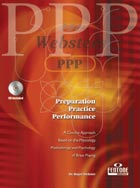Book Review - Preparation, Practice, Performance
1-Sep-2006Paula Russell, Principal Cornet for Brisbane Excelsior, reviews Dr Roger Webster's new book Preparation, Practice, Performance.

The long awaited publication of Roger Websters new tome on performance practice kept me eagerly waiting and wondering just what to expect. The reason for my eagerness lies in the need for fresh perspectives to keep motivation and enjoyment at a high, and Roger's injection of concepts in 'PPP' did not disappoint me in this respect.
How to buy...
All roads lead to performance
The long awaited publication of Roger Websters new tome on performance practice kept me eagerly waiting and wondering just what to expect. The reason for my eagerness lies in the need for fresh perspectives to keep motivation and enjoyment at a high, and Rogers injection of concepts in 'PPP' did not disappoint me in this respect.
'PPP' (Preparation, Practice & Performance), book with CD, is written for both student and teacher alike and does have some similar qualities to Howard Snell's fantastic book 'The Trumpet'.
Whilst covering a very broad area of topics 'PPP' does in fact manage to get into the nitty-gritty that we really want from an instruction book with the underlying message throughout that 'all roads lead to performance'.
There are three main areas up for discussion in this study and they are the Physiological, Methodological and Psychological approaches to brass performance and preparation.
Keep it simple, make it easy
First up on the menu, after a brief introduction, and personally my favorite section is the 'Warm-Up'.
If I had a dollar for every time I saw somebody walk into a band room, sit down and play without the merest sniff of a warm up I could comfortably take on Bill Gates. To those people I would say do yourself a favor and read these six pages!
What you will find here is a very eloquent and well written chapter with well thought out reasons and clear explanations about why we should warm up and the benefits this will give.
But it doesn't stop just there, as Dr. Webster talks about various stages of the warm-up such as the 'Pre Warm-up', including breathing and the importance of good inhalation/exhalation. Having gone right through this book, the importance of what is written here only gets put into perspective whilst being applied to some actual warm up examples that appear later on. If you only buy the book for this section it has been a worthy investment.
Now comes Rogers take on the much asked question of 'how do we practice?'. This part of the study takes us into the nuts and bolts behind all the writing (methodological) and actually gives us examples and studies to put what has been spoken about into practice.
Developing a consistent practice routine can be one of the most difficult things a player has to go through and is usually a trial and error affair. What I really like is how he has managed to condense the answer to 'how do we practice' into a simple equation (T + M + Ps=Q.P. Buy the book if you want to find out what it means!) , along with well thought out explanations to the above.
Two thirds of 'PPP" are devoted to real world exercises and studies (accompanied by a CD of examples of how exactly these should be practiced – a worthy inclusion) and it is constantly enforced throughout that we should understand why these have been written, what they do and how to do them before we put them into practice.
I think, like Snell's 'The Trumpet', this is not a cover to cover affair here but more things that can be 'slotted' into your own routine ( i.e. ..used like a reference book).
As I mentioned earlier, there are a broad range of topics covered in this book and here is no exception. Included is work for the development of inner and outer embouchure, flexibility, air stream and vibrato amongst other things, all with well though out reasoning and advice.
The final section of 'PPP' is focused on perhaps the most difficult of subjects to approach, performance anxiety. As Dr. Webster himself states, this section of the study has been somewhat simplified and for me glosses over the subject just a little too much. Not to take anything away from it however as this is a tricky area and there has been a very good attempt to include as much information as possible in a small space without over complicating the matter. I would really liked to have seen more actual exercises and real world examples but there is a lot here to enable you to continue your own research and study (such as cognitive therapy and positive self talk). I would maybe recommend that someone wanting specifically to concentrate on this area arm them self, also, with such books as 'The Inner Game of Music' (Green & Gallwey) or 'The Art of Practicing (Bruser).
So what do I really think...?
Basically I really enjoyed this book. It wasn't too heavy yet still gave me enough information to wet my appetite and make me feel that I could really take something worthwhile from it to apply to my everyday practice routine. It injects fresh ideas and thought into a somewhat 'saturated' market of brass study methods, but where this differs is that it actually explores more areas and a wider variety of subjects, some in depth and some as an introduction. I would recommend this book to both students and teachers alike as a worthy inclusion into everyday practice and performance preparation.
Paula Russell
Principal Cornet, Brisbane Excelsior



